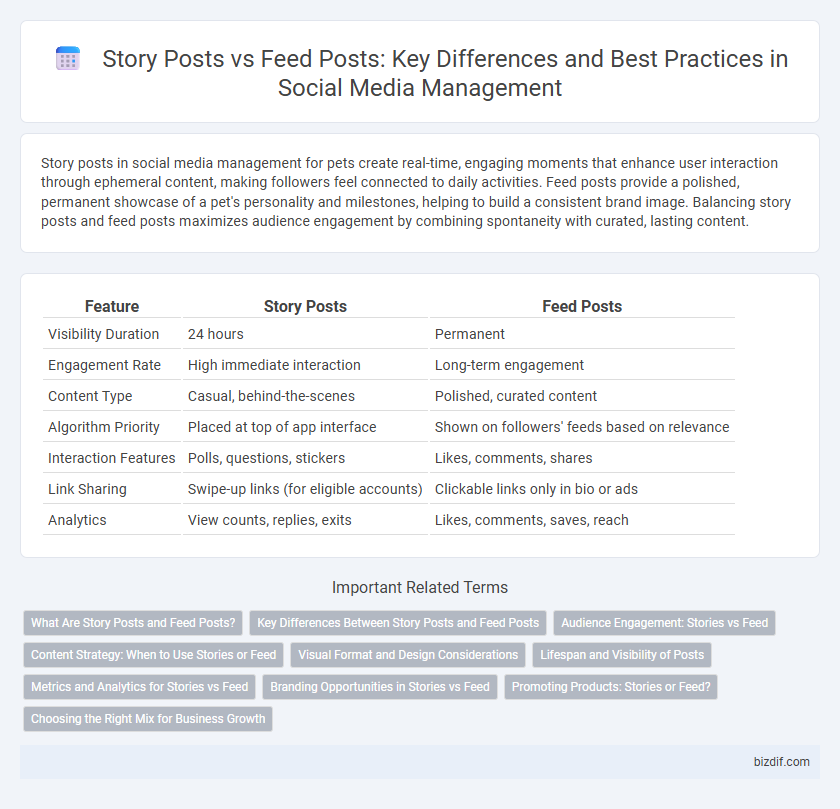Story posts in social media management for pets create real-time, engaging moments that enhance user interaction through ephemeral content, making followers feel connected to daily activities. Feed posts provide a polished, permanent showcase of a pet's personality and milestones, helping to build a consistent brand image. Balancing story posts and feed posts maximizes audience engagement by combining spontaneity with curated, lasting content.
Table of Comparison
| Feature | Story Posts | Feed Posts |
|---|---|---|
| Visibility Duration | 24 hours | Permanent |
| Engagement Rate | High immediate interaction | Long-term engagement |
| Content Type | Casual, behind-the-scenes | Polished, curated content |
| Algorithm Priority | Placed at top of app interface | Shown on followers' feeds based on relevance |
| Interaction Features | Polls, questions, stickers | Likes, comments, shares |
| Link Sharing | Swipe-up links (for eligible accounts) | Clickable links only in bio or ads |
| Analytics | View counts, replies, exits | Likes, comments, saves, reach |
What Are Story Posts and Feed Posts?
Story posts are temporary social media updates, typically lasting 24 hours, designed to share real-time moments and engage followers through interactive features like polls and stickers. Feed posts are permanent content displayed on a user's profile grid, optimized for discoverability and long-term engagement through captions, hashtags, and high-quality visuals. Understanding the distinct purposes and formats of story posts and feed posts helps brands strategically balance real-time interaction with sustained content visibility.
Key Differences Between Story Posts and Feed Posts
Story posts on social media offer ephemeral content that disappears after 24 hours, encouraging real-time engagement and authentic interactions. Feed posts provide permanent visibility on a profile, ideal for curated, high-quality content that supports brand identity and long-term messaging. Stories often utilize interactive features like polls and stickers to boost engagement, while feed posts drive sustained reach through likes, comments, and shares.
Audience Engagement: Stories vs Feed
Story posts generate higher real-time audience engagement due to their ephemeral nature, encouraging quick interactions like polls and swipe-ups. Feed posts provide lasting visibility, fostering sustained engagement through comments, likes, and shares over time. Leveraging both formats strategically maximizes reach and deepens connections by combining immediacy with permanence.
Content Strategy: When to Use Stories or Feed
Story posts excel in real-time engagement and transient updates, ideal for limited-time offers, behind-the-scenes glimpses, and interactive polls, driving immediate user interaction. Feed posts provide lasting content that enhances brand identity, supports SEO through captions and hashtags, and encourages sustained viewer engagement via likes, comments, and shares. A balanced content strategy leverages stories for urgency and spontaneity while using feed posts to build a cohesive narrative and deepen audience connection over time.
Visual Format and Design Considerations
Story posts leverage vertical, full-screen visuals optimized for mobile viewing, emphasizing immediacy and engagement through interactive elements like polls and swipe-ups. Feed posts favor square or landscape formats with consistent branding, curated aesthetics, and high-quality imagery to maintain a polished profile appearance. Effective social media management balances the dynamic, ephemeral nature of story posts with the enduring, visually cohesive appeal of feed content to maximize audience reach and retention.
Lifespan and Visibility of Posts
Story posts on social media have a limited lifespan of 24 hours, providing ephemeral but highly engaging visibility that encourages immediate interaction. Feed posts remain permanently on a profile, offering extended visibility and ongoing engagement opportunities through likes, comments, and shares over time. Brands often use story posts for timely announcements and real-time updates, while feed posts are optimized for long-term content discovery and audience growth.
Metrics and Analytics for Stories vs Feed
Story posts on social media typically generate higher engagement rates through metrics like completion rate and tap-forward percentage, which indicate viewer retention and interest within the 24-hour lifespan. Feed posts, on the other hand, offer more durable analytics such as reach, impressions, and comment rate that measure long-term interaction and discoverability over time. Brands analyzing these distinct metrics can optimize content strategy by leveraging the immediate engagement of stories and the sustained visibility of feed posts to maximize overall audience impact.
Branding Opportunities in Stories vs Feed
Story posts offer ephemeral, real-time branding opportunities that create a sense of urgency and exclusivity, enhancing audience engagement with behind-the-scenes content and interactive features like polls and quizzes. Feed posts contribute to long-term brand identity by showcasing curated, high-quality visuals and consistent messaging that solidify brand recognition and trust. Utilizing both formats strategically maximizes brand visibility and fosters a deeper connection with diverse audience segments.
Promoting Products: Stories or Feed?
Story posts offer fleeting visibility with a sense of urgency, driving immediate engagement and impulse buying, making them ideal for limited-time promotions and flash sales. Feed posts provide lasting presence, allowing detailed product information and visuals that improve brand recall and organic discovery through hashtags. Combining both maximizes product promotion by leveraging Stories for time-sensitive offers and Feed posts for sustained brand awareness.
Choosing the Right Mix for Business Growth
Story posts offer ephemeral, engaging content that drives real-time interaction and boosts visibility through algorithms favoring recent activity. Feed posts create a lasting brand presence with high-quality visuals and detailed captions that enhance credibility and support search optimization. Combining both formats strategically maximizes audience reach, engagement rates, and sustained business growth on social media platforms.
story posts vs feed posts Infographic

 bizdif.com
bizdif.com